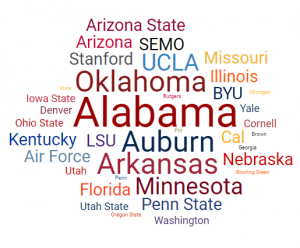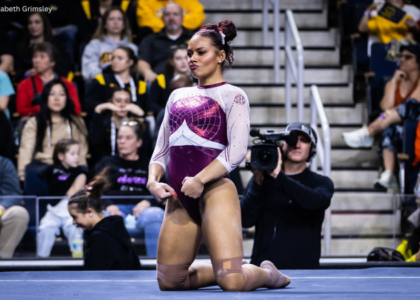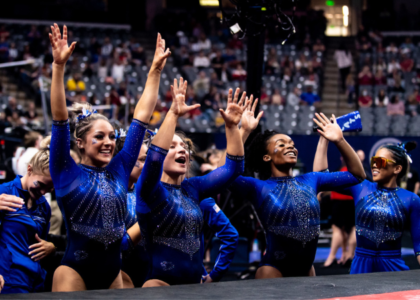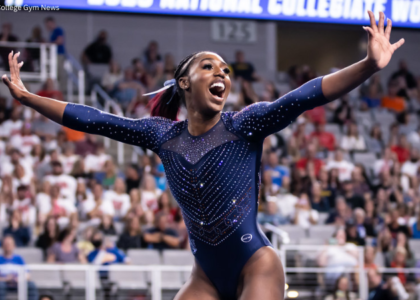We’ve all heard the refrain: Texas should have a DI gymnastics program! It makes sense, off hand, because there are so many strong J.O. clubs in Texas that regularly send gymnasts to top DI schools. Texas is the strongest state in J.O. Region 3, yet it doesn’t have a DI program. We break down the argument and look at how many Texas athletes are currently competing for DI programs, Texas’ showing at J.O. nationals last year and geographically where top Texas clubs are located in relation to the DI schools that could theoretically support a program.
The foremost argument for a DI team in Texas is also the simplest: 12 more scholarships would be good for the sport. NCAA gymnastics’ recently-released website includes a statement about its growth initiative: “The Collegiate Gymnastics Growth Initiative (CGGI), was formed to promote awareness in the pursuit and addition of new women’s collegiate gymnastics programs across the country, thus providing more opportunities for college bound gymnasts.” It is encouraging that the NCAA is hoping to expand gymnastic competition. So, why Texas?
We argue repeatedly that Texas is a powerhouse gymnastics state, but we rarely see the statistics. In the upcoming 2018 season, there will be 97 gymnasts competing for 37 DI teams whose hometowns are in the state. Alabama leads the pack seven Texas gymnasts.

The majority of those 97 athletes come from four clubs: WOGA (18), Texas Dreams (12), Metroplex (11) and Stars (11). A total of 27 Texas clubs will have former athletes competing with DI programs in 2018.

The upcoming season is not an anomaly. Texas shows strong signs of high recruiting numbers for years to come. Successful DI programs recruit top amateur elites as well as J.O. national qualifiers and Nastia Cup competitors. Texas sent 68 gymnasts to J.O. nationals, five to the Nastia Cup and there are three current members of the National Team who hail from Texas. For perspective, Region 3 (Arkansas, Colorado, Kansas, New Mexico, Oklahoma, Texas and Wyoming) sent 94 gymnasts to nationals. Texas’ 68 athletes represent 72 percent of Region 3 gymnasts at the meet. Overall, Region 3 represented 13.7 percent of the 683 nationals competitors; Texas totalled about 10 percent of all nationals qualifiers. The 2017 Nastia Cup had 36 competitors across both juniors and seniors. Texas’ five gymnasts make up 13.8 percent of that group, outnumbering all other states.
The NCAA acknowledges that the lack of a Texas program is odd, though that does not make the prospect of adding a team any easier. The University of Texas at Austin (UT) is the most obvious choice for a program: It is the state’s flagship university, part of the Big 12—a conference that already supports gymnastic competition—and even had a team until 1981. In 2015, International Gymnast reported that a 1993 Title IX lawsuit against UT sought the addition of a gymnastics team, among several other women’s sports, but the team never materialized. The same article notes that Mary Lou Retton, a UT alumna, offered the school funds to begin the program to no avail.
If orange Longhorns leotards are not forthcoming (how amazing would those be?!), which schools are primed to host a gymnastics team? There are 23 DI programs in Texas. Nine of those currently have an NAIGC club gymnastics program: Texas Tech, University of North Texas, Texas Christian University, Baylor, Texas A&M, University of Houston, UT-San Antonio, Texas State University and UT-Austin. Below is a list of those seven institutions, plus three other DI schools with sizeable student bodies and large athletic departments. Several of the schools are in conferences with gymnastic competition (namely the Big 12 and SEC), but many are in other conferences. If one of those institutions were to adopt a gymnastics team, it is likely they would become associate members of another conference with gymnastic competition (for example, Denver is currently a member of the Big 12, only competing in gymnastics in that conference).
To get an idea of where exactly top Texas clubs are in relation to the programs below, take a look at our interactive map.
Candidate Programs:
Baylor University
![]() Waco | Big 12
Waco | Big 12
⚐ Bears/Lady Bears | Green and Gold
Baylor is situated between Dallas and Austin, and has an NAIGC club and a competitive women’s acrobatics and tumbling team. As of 2016, Baylor has a new athletic director and is working to overcome allegations of misconduct toward women from the football team. Adding an additional women’s sport would be a boost for the athletic department’s image, and Baylor’s location would be prime for recruiting in the Dallas, Houston and Austin metropolitan areas. Gymnastics at Baylor would join Big 12 teams Denver, Iowa State, Oklahoma and West Virginia—also making for a more competitive conference championship.
University of Houston
![]()
![]()
![]()
![]()
![]()
![]()
![]()
![]()
![]()
![]()
![]()
![]()
⚐ Cougars | Red and White
The University of Houston also has an NAIGC club and is rumored to be investigating adding a varsity program. Strong club programs near Houston include Pearland Elite, Stars, Flips and World Champions Centre. If Houston were to adopt gymnastics, it would need to become an associate member of another conference. Perhaps it would join the SEC, given its proximity to LSU, Alabama and Arkansas.
University of North Texas
![]()
![]()
![]()
![]()
![]()
![]()
![]()
![]()
![]()
![]()
![]()
![]()
⚐ Mean Green | Green, Black and White
North Texas is in Denton, just outside Dallas. The Dallas metropolitan region is a hotbed of gymnastics talent, including Metroplex, WOGA and Texas Dreams. The school has a club gymnastics program, and the prospect of having a team that goes by Mean Green, and uses green heavily in its athletic wear, is fun for leotard lovers. North Texas is another university that would need to join a conference for gymnastics. Denton is also the home of Texas’ lone collegiate program: DII’s Texas Woman’s University. If North Texas were to add DI gymnastics, it could cut into TWU’s recruiting and fan base.
Sam Houston State University
![]()
![]()
![]()
![]()
![]()
![]()
![]()
![]()
![]()
![]()
![]()
![]()
⚐ Bearkats | Gold and White
Sam Houston State does not currently have a club gymnastics team, though they do have some non-traditional women’s’ sports, such as bowling. Huntsville is north of Houston, almost halfway to Dallas and is in the perfect location to recruit from both cities and the Austin and San Antonio areas. Sam Houston State would need to become an associate member of another conference to compete in gymnastics.
Southern Methodist University
![]()
![]()
![]()
![]()
![]()
![]()
![]()
![]()
![]()
![]()
![]()
![]()
⚐ Mustangs | Red and Blue
SMU fields some interesting women’s teams, including equestrian, golf and rowing. Perhaps the school would be interested in adding a Mustang gymnastics team, despite currently not having a club program. SMU is in Dallas, near the most productive Texas teams. It would need to become an associate member of another conference.
Texas Christian University
![]()
![]()
![]()
![]()
![]()
![]()
![]()
![]()
![]()
![]()
![]()
![]()
⚐ Horned Frogs/Lady Frogs | Purple and White
Lady Gym Frogs would be a lot of fun! TCU has a proud athletics tradition, supporting some lesser-known sports like rifle. They do currently have a club gymnastics program and are a part of the Big 12. Fort Worth is just outside Dallas, near Texas Dreams, WOGA and Metroplex.
University of Texas at Austin
![]()
![]()
![]()
![]()
![]()
![]()
![]()
![]()
![]()
![]()
![]()
![]()
⚐ Longhorns | Orange and White
Unfortunately, it does not seem like UT-Austin will adopt a gymnastics team. If MLR can’t convince her alma mater to do it, we’re not sure anyone can. The school reportedly is not interested in hosting programs that won’t allow athletes to pursue professional leagues or an Olympic spot after college. Still, it’s one of the best candidates since it is in the Big 12, has had a program previously and currently has a club team. Plus, UT-Austin is already an Oklahoma rival, so adding gymnastics to that fire would be exciting for fans of both schools – because who doesn’t love a new reason to hate their school’s rival?
Texas A&M University
![]()
![]()
![]()
![]()
![]()
![]()
![]()
![]()
![]()
![]()
![]()
![]()
⚐ Aggies | Maroon and White
The Aggies are the lone SEC program in the state of Texas. An A&M gymnastics team would go up against some of the most storied programs in gymnastics, including Alabama and Georgia. The university holds football rivalries with Arkansas and LSU, which could make for an exciting gymnastics atmosphere. A&M has a club gymnastics team and is located in the center of a triangle created by Dallas, Houston and Austin, in close proximity to nearly every productive J.O. club in the state.
Texas State University
![]()
![]()
![]()
![]()
![]()
![]()
![]()
![]()
![]()
![]()
![]()
![]()
⚐ Bobcats | Maroon and Gold
Texas State currently supports a club gymnastics team. Located between San Antonio and Austin, the Bobcats are in close proximity to Capital Gymnastics and Aerial Athletics, two strong programs in the state. Texas State would need to join a conference for gymnastics—perhaps the Big 12 to develop a rivalry with Oklahoma, which is directly to its north.
Texas Tech University
![]()
![]()
![]()
![]()
![]()
![]()
![]()
![]()
![]()
![]()
![]()
![]()
⚐ Raiders/Lady Raiders | Red and Black
Texas Tech, located in Lubbock, is the lone program on this list outside the Dallas/Houston/San Antonio triangle. In the northwestern part of the state, Texas Tech is not particularly close to the strongest J.O. programs. The Lady Raiders have a club program, though, and the university is at the center of a large dead zone for NCAA programs. Because Texas Tech is in the Big 12, it would compete against Denver, Iowa State, Oklahoma and West Virginia.
University of Texas at San Antonio
![]()
![]()
![]()
![]()
![]()
![]()
![]()
![]()
![]()
![]()
![]()
![]()
⚐ Roadrunners | Navy, Orange and White
Perhaps if UT-Austin will not add gymnastics, UT-San Antonio will, though it would need to join a conference for gymnastics. The Roadrunners currently have a club team and are located near Aerial Athletics. The southernmost team on this list, the school could also perhaps start recruiting from some programs in the southern and western parts of Texas which currently don’t send athletes to DI programs.
Which Texas program would you like to see adopt a DI team? Let us know in the comments!
Join the conversation! Follow NCAA Gym News on Twitter, Facebook and Instagram.
Article by Emily Minehart





Baylor just miiiiiiiight have a bit of a recruiting challenge, especially in gymnastics where parents’ collective hackles should continue to be raised for some time.
I would have wanted UT but I’ll throw as much support as I can behind UH if they go ahead with it!